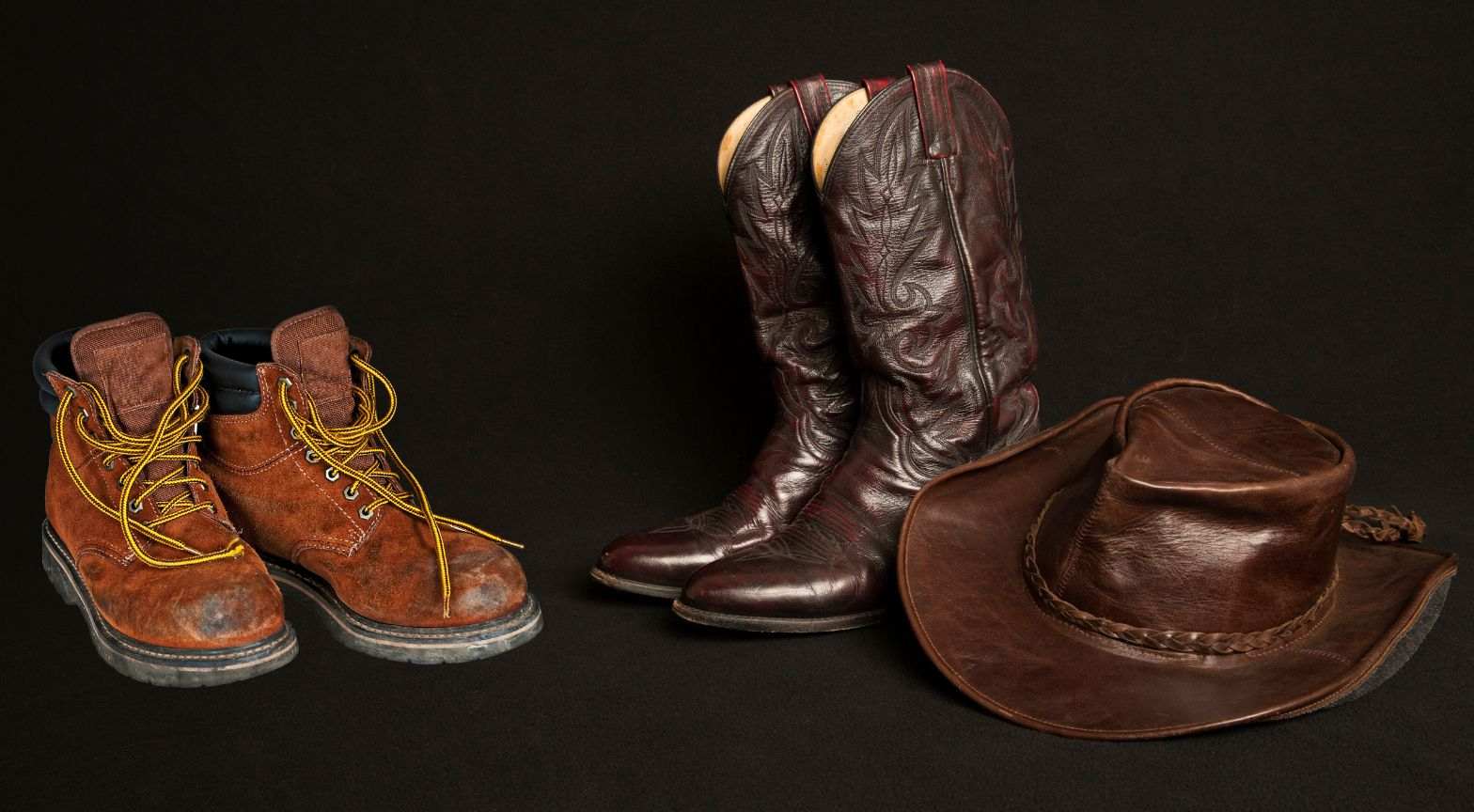Last Updated on August 1, 2024 by Sarah Jaffe
Howdy folks! If you’re here, chances are you’re stuck in a dilemma of cowboy boots vs work boots. Both are iconic, sturdy, and stylish footwear options that have been popular for decades. But which one is the right fit for you? If you work on a ranch or spend your days on horseback, cowboy boots may be calling your name.
However, if you’re in construction or any other field where safety is a top priority, work boots might be your go-to. But don’t worry, we’re here to help you make the right choice. We’ll break down the differences between the two, highlighting their unique features, comfortability, and durability. No more sore feet or broken toes – let’s get to it!
Cowboy Boots Vs Work Boots – Comparison Between The Two!

Cowboy boots and work boots are two distinct types of footwear that serve different purposes. Here is a comparison between the two based on their characteristics:
Toe Shape
Cowboy boots are known for their pointed toe, which is a defining feature of their design. This pointed-toe shape is rooted in the historical influence of riding boots.
On the other hand, work boots usually have a rounded or square toe shape. The rounded or square toe provides additional room and comfort for the toes, allowing for easier movement and reduced pressure.
Insoles

For all-day wear, work boots are designed to prioritize comfort. For extra cushioning and support, they often have cushioned insoles. Long hours of work are made easier with these cushioned insoles that absorb shocks and reduce fatigue.
In contrast, cowboy boots are not primarily focused on comfort. They may require some time to break in and conform to the shape of the wearer’s feet.
Outsole
An outsole made of rubber offers better traction and slip resistance in work boots. They are suitable for various work environments where slip hazards are present due to the rubber outsole’s reliable grip.
In contrast, cowboy boots typically have a leather outsole with a stacked leather heel. The leather outsole is more suited for walking on flat surfaces and indoor settings.
Security
Safety is the top priority when designing work boots. In comparison with cowboy boots, they are more durable and have built-in safety features. Work boots usually feature reinforced toes, metatarsal guards, electrical hazard protection, and puncture-resistant midsoles. Impacts, compression, electrical shocks, and punctures are all workplace hazards that these safety features protect against.
Cowboy boots, while offering some level of foot protection, are not designed with safety features in mind. They are more of a fashion statement and lack the specific safety enhancements found in work boots.
Material
Work boots are typically made of durable materials such as leather and synthetic materials. These materials provide strength, longevity, and protection against harsh working conditions.
Cowboy boots are typically made of leather, but they may also feature exotic materials such as alligator, snake, or ostrich. Using exotic materials in cowboy boots adds to their aesthetic appeal and uniqueness.
Heel
Stacking leather heels add height to cowboy boots and are a distinctive design feature. The stacked heel is often angled, contributing to the iconic Western-style look.
In contrast, work boots may have a flat or raised heel that provides added support and stability, especially in tasks that involve extensive standing or walking.
Shaft
The shaft of a cowboy boot usually reaches mid-calf. Riding horses or working in rugged terrain requires a tall shaft for ankle support and protection.
In most cases, the shaft of a work boot reaches the ankle. Since they have a shorter shaft, they are more flexible and easier to move, making them ideal for various work tasks.
Vamp
Cowboy boots have a decorative vamp, which is part of the boot that covers the instep. The vamp of cowboy boots often features intricate stitching, designs, or overlays, adding to their distinctive Western-style appearance.
Work boots, in contrast, have a plain vamp that is designed for durability and protection. The focus is on providing a sturdy and protective covering for the foot.
Comfort
For prolonged wear, work boots are made to prioritize comfort. To ensure all-day comfort, they feature cushioned insoles, breathable materials, and ergonomic designs. Foot fatigue is reduced and enhanced support is provided by these features.
Conversely, cowboy boots are not primarily designed to provide comfort. In spite of the fact that they may take time to break in and conform to the wearer’s feet, they are often chosen for their style and fashion appeal rather than their comfort.
Cowboy Boots: An Iconic Western Footwear
History And Origins Of Cowboy Boots
Cowboy boots have a rich history that can be traced back to the 18th century. The origins of these boots can be attributed to the Spanish vaqueros who introduced their traditional riding boots to the Americas. Over time, as cowboys adapted to the rugged conditions of the American West, these boots evolved to meet their needs.
Characteristics and Features of Cowboy Boots
Design: Cowboy boots typically feature a tall shaft that covers the calf, providing protection and support. They often showcase decorative stitching, intricate designs, or embellishments that add a touch of Western style.
Material: High-quality leather is commonly used for crafting cowboy boots due to its durability and flexibility. However, other materials such as exotic leathers, suede, or synthetic materials are also utilized.
Heel Height: Slanted heels distinguish cowboy boots. For everyday wear, low heels are appropriate, while higher heels are appropriate for formal occasions. In the stirrup, the angled heel keeps the foot secure.
Best Uses for Cowboy Boots
Fashion: Cowboy boots have transcended their practical roots and are now embraced as a fashion statement. They are worn by individuals seeking a Western-inspired aesthetic or those who appreciate their unique style.
Rodeo Events: In rodeo culture, cowboy boots are worn by participants in various events such as bull riding, roping, and barrel racing. Support, grip, and protection are provided by the boots during these activities.
Market Growth
From 2022 to 2032, the global cowboy boot market is expected to reach US$ 225 million, according to market research. A compound annual growth rate of 6.9% is projected for this industry. Western fashion and cowboy boots’ popularity as style statements contribute to this growth.
Work Boots: Footwear Designed For Safety And Durability
History and Origin of Work Boots
Work boots have a long history that dates back to the industrial revolution when the need for specialized footwear for hazardous workplaces arose. The earliest work boots were crafted to provide protection and support to workers in factories, mines, and construction sites.
Types of Work Boots
Work boots are specifically designed to provide protection and comfort for individuals engaged in various demanding occupations. Some common types of work boots include:
Steel-Toe Boots: These boots feature a reinforced toe cap made of steel or composite materials to protect the toes from heavy objects or compression.
Waterproof Boots: Designed with waterproof materials and construction techniques, these boots keep the feet dry and comfortable, especially in wet or muddy conditions.
Insulated Boots: Insulated work boots are equipped with additional layers of insulation, typically made of materials like Thinsulate™, to provide warmth and comfort in cold environments.
Characteristics and Features of Work Boots
Safety Features: Work boots feature steel toecaps, puncture-resistant soles, electrical hazard protection, and metatarsal guards. As a result, these features help protect workers from workplace hazards.
Durability: Work boots are built to withstand heavy use and harsh conditions. They are made from robust materials like leather or synthetic materials known for their durability.
Slip-Resistance: Many work boots incorporate slip-resistant outsoles to provide enhanced traction and reduce the risk of slips and falls, particularly on slippery surfaces.
Work Boots Market Growth
The work boots market is projected to reach a value of USD 26.5 billion by 2032, with a CAGR of 9.2% from 2022 to 2032. A large part of this growth is attributed to an increased focus on providing comfortable and protective footwear for workers across a variety of industries. There has been a rise in awareness of workplace safety regulations and the need for durable and reliable footwear in recent years.
FAQs
Can You Use Cowboy Boots for Work?
A: Yes, you can use cowboy boots for work as long as there are no restrictions against them. Before wearing your boots all day at work, you should ensure that they have been broken in. Due to their lack of safety features, cowboy boots are unsuitable for use on construction sites or in other heavy environments. Cowboy boots do not have many safety features or reinforcements, making them less suitable for a variety of tasks in harsh environments. Work boots do.
Can cowboy boots be worn with work attire?
Yes, you can wear cowboy boots to work. The wearing of cowboy boots may be appropriate in certain industries, such as agriculture or ranching, but not in others. Work boots are a better choice for industries that require safety features and durable footwear.
Can cowboy boots be worn for outdoor activities?
Yes, cowboy boots are suitable for wearing outdoors, such as hiking or horseback riding. However, they may not provide the same level of protection and support as work boots, which are more suitable for rugged outdoor environments.
Can work boots be worn as casual wear?
Yes, you can wear work boots casually. In recent years, work boots have become a popular fashion trend, and many brands have started producing work boots with stylish designs.
Which type of boot is more expensive: cowboy or work boot?
The price of both cowboy and work boots can vary depending on the brand and materials used. Due to their durable construction and additional features, high-quality work boots tend to be more expensive than cowboy boots. Due to their unique designs and materials, designer cowboy boots can also be quite expensive.
Can cowboy boots be resoled like work boots?
Yes, Cowboy boots can be resoled, and the process is similar to resoling work boots. A cobbler can remove the old sole and replace it with a new one
Conclusion
Choosing the right footwear is crucial to one’s comfort, safety, and productivity. It is important to consider the specific needs of the job or activity when choosing cowboy boots vs work boots. Western-themed events and riding horses may require cowboy boots, but other activities may require boots that provide support and protection.
Work boots, on the other hand, are designed to handle tough environments and provide support and safety features. Shoes are essential for preventing injuries, reducing fatigue, and improving performance on the job. Identifying the appropriate footwear based on the intended use requires weighing the pros and cons of each type.

Sarah is the brains behind BootsNerd. Sarah Jaffe is a writer, editor, and boots lover based in Brooklyn, New York. She has done BA (Hons) in Footwear Design from De Montfort University, UK. She loves to write about boots and has a particular interest in vintage and sustainable fashion.